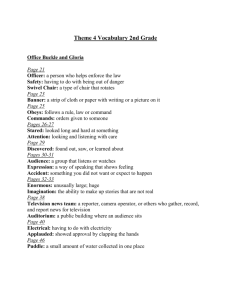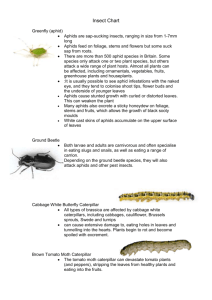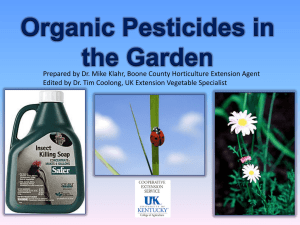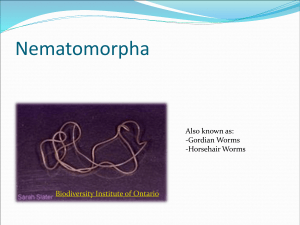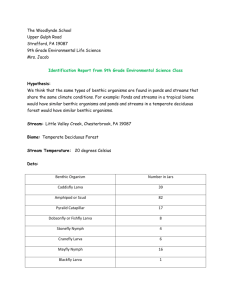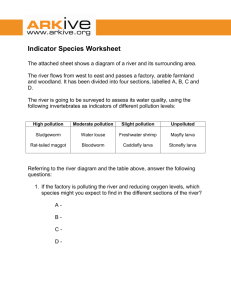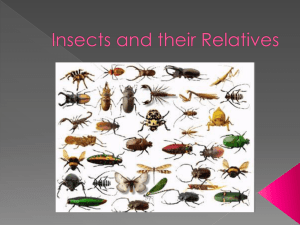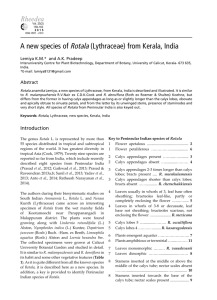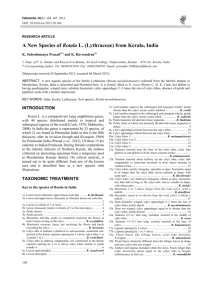St - Plymouth
advertisement
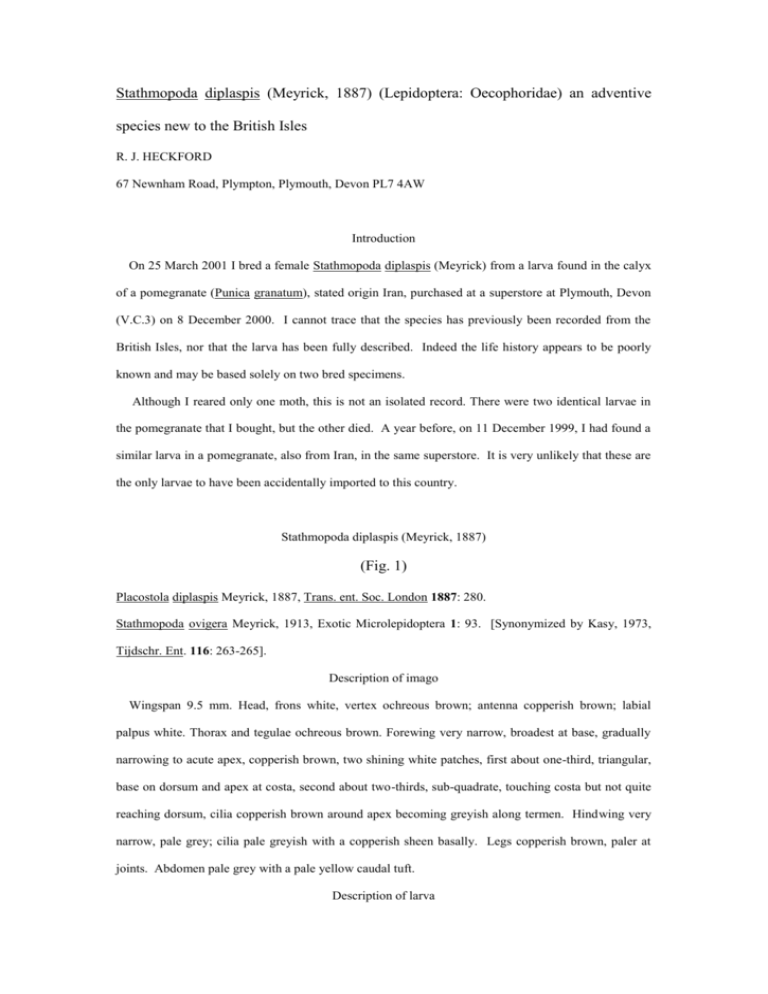
Stathmopoda diplaspis (Meyrick, 1887) (Lepidoptera: Oecophoridae) an adventive species new to the British Isles R. J. HECKFORD 67 Newnham Road, Plympton, Plymouth, Devon PL7 4AW Introduction On 25 March 2001 I bred a female Stathmopoda diplaspis (Meyrick) from a larva found in the calyx of a pomegranate (Punica granatum), stated origin Iran, purchased at a superstore at Plymouth, Devon (V.C.3) on 8 December 2000. I cannot trace that the species has previously been recorded from the British Isles, nor that the larva has been fully described. Indeed the life history appears to be poorly known and may be based solely on two bred specimens. Although I reared only one moth, this is not an isolated record. There were two identical larvae in the pomegranate that I bought, but the other died. A year before, on 11 December 1999, I had found a similar larva in a pomegranate, also from Iran, in the same superstore. It is very unlikely that these are the only larvae to have been accidentally imported to this country. Stathmopoda diplaspis (Meyrick, 1887) (Fig. 1) Placostola diplaspis Meyrick, 1887, Trans. ent. Soc. London 1887: 280. Stathmopoda ovigera Meyrick, 1913, Exotic Microlepidoptera 1: 93. [Synonymized by Kasy, 1973, Tijdschr. Ent. 116: 263-265]. Description of imago Wingspan 9.5 mm. Head, frons white, vertex ochreous brown; antenna copperish brown; labial palpus white. Thorax and tegulae ochreous brown. Forewing very narrow, broadest at base, gradually narrowing to acute apex, copperish brown, two shining white patches, first about one-third, triangular, base on dorsum and apex at costa, second about two-thirds, sub-quadrate, touching costa but not quite reaching dorsum, cilia copperish brown around apex becoming greyish along termen. Hindwing very narrow, pale grey; cilia pale greyish with a copperish sheen basally. Legs copperish brown, paler at joints. Abdomen pale grey with a pale yellow caudal tuft. Description of larva Head yellowish brown, mandibles dark brown, stemmata black; prothoracic plate translucent yellowish brown, showing the body colouring; body dull purplish brown, dull reddish brown in early instars, paler laterally and ventrally, thoracic segments 2 and 3 and abdominal segment 9 dull dark brown; pinacula small, paler than the body colour; thoracic legs translucent, dark brown at joints; ventral and anal prolegs translucent. Pupa pale reddish brown, in a slight, semi-transparent, whitish cocoon, and not extruded on emergence of the imago. Biology The three larvae were in slight silken tubes in the calyx of the pomegranates. I purchased several on each occasion and some, but not all, had apparently dead white scale insects within the calyx; I cannot recall whether there were any with the larvae. I did not provide the larvae with them, as I removed them from the calyx and gave the larvae parts of it, which meant subsequently purchasing a number of the fruit for this purpose as the calyx tends either to go mouldy or dessicate quite quickly. The larvae spun slight, whitish, semi-transparent silken tubes either in crevices in the base of the calyx or amongst the dried stamens on the inside of the calyx, and fed both on the flesh of the calyx and, apparently, on the dried stamens, but did not enter the fruit. The larva that produced the moth fed very slowly from the date of purchase until 23 February 2001 when it spun a cocoon. I do not know whether this lengthy feeding period is usual, whether it would have been quicker in natural conditions, or whether scale insects are part of the normal diet, without which the larva grows more slowly. Although it did grow in size, when it pupated it did not seem significantly larger than when the pomegranate was bought. In any event, it is clear that scale insects were not necessary for the larva to complete its growth, and the moth is not undersize, falling within the wingspan range, 9.3-10.5 mm, given by Kasy (1973: 263-265). In fact Meyrick (1887: 280; 1913: 93) gives the wingspan of Stathmopoda diplaspis as 8 mm and Stathmopoda ovigera as 8-9 mm. I made my identification at The Natural History Museum, London (BMNH), where there are six specimens under Stathmopoda diplaspis and 21 under Stathmopoda ovigera. Only two of these have been reared. The labels on each specimen have the same data, except for the date: ‘5.XII.16/ SOUTH INDIA/ COIMBATORE/Pred (sic) ?. on Pulvinaria/on Ficus glomerata [now F. racemosa]/Y. R. RAO COLL.’; the date of the other is ‘1.XII.16’. The former data label is attached to the moth standing under Stathmopoda diplaspis and the other under Stathmopoda ovigera. Both have been dissected, as well as a further specimen from each series, by Kasy who synonymized the two taxa in 1973 (loc. cit.). He did not mention these bred specimens, but it seems clear that his comments are based on them and that they are probably the only larval records that he could trace. All that he says about the biology is that the larva has been found on Ficus glomerata, where it lives in a possibly predatory manner on coccids of the genus Pulvinaria: ‘…nach dem die Raupe an Ficus glomerata gefunden wurde und an dieser Pflanze möglicherweise räuberisch von Schildläusen der Gattung Pulvinaria gelebt hat’. In fact Fletcher (1920: 121), not mentioned by Kasy, says of ovigera: ‘This species was originally described from Puttalam (Ceylon). It has since been bred from blackish larvae found in fluffy masses of Pulvinaria sp. on Ficus glomerata at Coimbatore in December 1916’. The moth and larva are illustrated on Plate XXVIII, Fig. 2 (uncoloured) of that publication. It seems reasonable to assume that the two bred specimens in the BMNH, which may have been the only specimens that were reared, are the subject of Fletcher’s account, and that Kasy’s comments on the biology is based on them. Dr S. Yu. Sinev tells me (in litt.) that he is not aware of any other published information about the biology, nor any further larval description. Pulvinaria is a genus of scale insects, with members in the British Isles, in the Order Hemiptera, Suborder Sternorrhyncha, Superfamily Coccoidea, Family Coccidae. The Coccoidea are a very difficult group to identify and cannot safely be determined without preparation of slide mounts. Whether or not the scale insects of Coimbatore were correctly determined may not be important because in the experience of Dr G. W. Watson (in litt.) larvae that attack scale insects are not specific about the genus and will often feed on members of more than one scale insect family. This assume that such insects, or their exudations, are a normal part of the larval diet, but whether this is so or the fact that both taxa are found together is coincidental remains to be determined. Remarks The colour and pattern of the forewing of Stathmopoda diplaspis are so distinctive that the species could not be confused with any other on the British list. Kasy (loc. cit.) places it in taxonomic order well before Stathmopoda pedella (Linnaeus, 1761), hitherto the only member of the genus recorded from the British Isles. If this order were adopted following the current British checklist (Bradley, 2000) then Stathmopoda diplaspis, in Stathmopodinae, would come immediately after Carcina quercana (Fabricius, 1775), which Bradley places in the subfamily Carcininae allocating it the number 658. This would result in Stathmopoda diplaspis being numbered 658a, possibly suggesting that it was in Carcininae. I suggest that to avoid this, Stathmopoda diplaspis should be placed immediately after S. pedella and be given the number 877a. Distribution The species is rather widely distributed in central and south-west Asia: Saudia Arabia; Iran; Afghanistan; Pakistan; India and Sri Lanka (Kasy, 1973: 263-265); Tajikistan (Falkovitsh & Sinev, 1988: 109); Afghanistan (Dr S. Yu Sinev pers. comm.) and Thailand (specimens in the BMNH). Acknowledgements I am very grateful to Mr M. R. Honey (BMNH) both for photographing the moth and other assistance, Mr G. Morton (Wallingford) for producing the print, I acknowledge the copyright in the photograph as belonging to the Trustees of the BMNH, and to Dr G. W. Watson (BMNH) for information about the Coccoidea. I also thank Ms J. Harvey and Ms V. Veness (both of the Entomology Library, BMNH), Mr J. C. Koster (Callantsoog), Dr G. S. Robinson and Dr K. Sattler (both BMHN) and Dr S. Yu. Sinev (St Petersberg) for their help in various ways. References Bradley, J. D. 2000. Checklist of Lepidoptera recorded from the British Isles vi, 116. Fordingbridge. Falkovitsh, M. I. & Sinev, S. Yu. 1988. A review of bright-legged moths (Lepidoptera, Stathmopodidae) in the fauna of the USSR. USSR Academy of Sciences. Proceedings of the Zoological Institute, Leningrad Trudy Zool. Inst. Leningrad 178: 104-133, 31 text-figs. [in Russian]. Fletcher, T. Bainbrigge. 1920. Life-histories of Indian insects. Microlepidoptera. V. Heliozelidae, Heliodinidae, Glyphipterygidae, Blastobasidae and Hyponomeutidae. Mem. Dep. Agric. India 6: 1-217. Kasy, F. 1973. Beitrag zur Kenntnis der Familie Stathmopodidae Meyrick, 1913 (Lepidoptera, Gelechioidea) Tijdschr. Ent. 116: 227-299. Meyrick, E. 1887. Descriptions of some exotic Micro-Lepidoptera. Trans. ent. Soc. London 1887: 269-280. ----------- 1913. Exotic Microlepidoptera 1. Part 3. 65-96 pp. London. LEGEND Fig. 1. Stathmopoda diplaspis (Meyrick)
